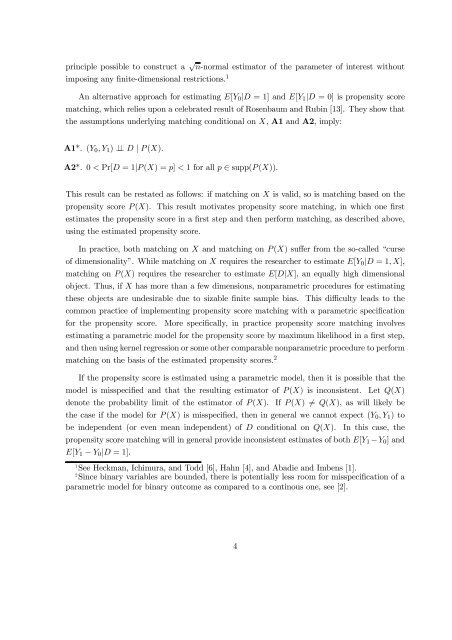On the Identification of Misspecified Propensity Scores - School of ...
On the Identification of Misspecified Propensity Scores - School of ...
On the Identification of Misspecified Propensity Scores - School of ...
Create successful ePaper yourself
Turn your PDF publications into a flip-book with our unique Google optimized e-Paper software.
principle possible to construct a √ n-normal estimator <strong>of</strong> <strong>the</strong> parameter <strong>of</strong> interest without<br />
imposing any finite-dimensional restrictions. 1<br />
An alternative approach for estimating E[Y0|D = 1] and E[Y1|D = 0] is propensity score<br />
matching, which relies upon a celebrated result <strong>of</strong> Rosenbaum and Rubin [13]. They show that<br />
<strong>the</strong> assumptions underlying matching conditional on X, A1 and A2, imply:<br />
A1*. (Y0, Y1) ⊥ D | P (X).<br />
A2*. 0 < Pr[D = 1|P (X) = p] < 1 for all p ∈ supp(P (X)).<br />
This result can be restated as follows: if matching on X is valid, so is matching based on <strong>the</strong><br />
propensity score P (X). This result motivates propensity score matching, in which one first<br />
estimates <strong>the</strong> propensity score in a first step and <strong>the</strong>n perform matching, as described above,<br />
using <strong>the</strong> estimated propensity score.<br />
In practice, both matching on X and matching on P (X) suffer from <strong>the</strong> so-called “curse<br />
<strong>of</strong> dimensionality”. While matching on X requires <strong>the</strong> researcher to estimate E[Y0|D = 1, X],<br />
matching on P (X) requires <strong>the</strong> researcher to estimate E[D|X], an equally high dimensional<br />
object. Thus, if X has more than a few dimensions, nonparametric procedures for estimating<br />
<strong>the</strong>se objects are undesirable due to sizable finite sample bias. This difficulty leads to <strong>the</strong><br />
common practice <strong>of</strong> implementing propensity score matching with a parametric specification<br />
for <strong>the</strong> propensity score. More specifically, in practice propensity score matching involves<br />
estimating a parametric model for <strong>the</strong> propensity score by maximum likelihood in a first step,<br />
and <strong>the</strong>n using kernel regression or some o<strong>the</strong>r comparable nonparametric procedure to perform<br />
matching on <strong>the</strong> basis <strong>of</strong> <strong>the</strong> estimated propensity scores. 2<br />
If <strong>the</strong> propensity score is estimated using a parametric model, <strong>the</strong>n it is possible that <strong>the</strong><br />
model is misspecified and that <strong>the</strong> resulting estimator <strong>of</strong> P (X) is inconsistent. Let Q(X)<br />
denote <strong>the</strong> probability limit <strong>of</strong> <strong>the</strong> estimator <strong>of</strong> P (X). If P (X) = Q(X), as will likely be<br />
<strong>the</strong> case if <strong>the</strong> model for P (X) is misspecified, <strong>the</strong>n in general we cannot expect (Y0, Y1) to<br />
be independent (or even mean independent) <strong>of</strong> D conditional on Q(X). In this case, <strong>the</strong><br />
propensity score matching will in general provide inconsistent estimates <strong>of</strong> both E[Y1 −Y0] and<br />
E[Y1 − Y0|D = 1].<br />
1 See Heckman, Ichimura, and Todd [6], Hahn [4], and Abadie and Imbens [1].<br />
2 Since binary variables are bounded, <strong>the</strong>re is potentially less room for misspecification <strong>of</strong> a<br />
parametric model for binary outcome as compared to a continous one, see [2].<br />
4
















